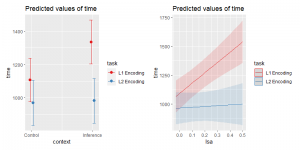線形混合効果モデルの作成
1 2 3 4 5 6 7 8 9 10 11 12 13 14 15 16 17 18 19 20 21 22 23 24 25 | library(lme4)library(lmerTest)library(ggplot2)library(sjPlot)library(sjmisc)######## Data# 2条件×2条件で複数のitemを学習した際の交互作用を見たい。# 従来は2 × 2 ANOVAを使用。# 反復測定デザインでの線形混合効果モデル# 従属変数がordinalの場合は一般化線形モデル######## Model Description# model.1: Fixed Slope and Intercept (通常の重回帰分析)model.1 <- lm(time ~ context + task + context : task, data = dat) # model.2: Fixed Slope and Random Interceptmodel.2 <- lmer(time ~ context * task + (1 | pid) + (1 | item), data = dat)# model.3: Random Slope and Intercept for Participantmodel.3 <- lmer(time ~ context * task + (context * task | pid) + (1 | item), data = dat)# model.4: Random Slope and Intercept for Itemmodel.4 <- lmer(time ~ context * task + (1 | pid) + (context * task | item), data = dat)# model.5: Random Slope and Interceptmodel.5 <- lmer(time ~ context * task + (context * task | pid) + (context * task | item), data = dat)# model.6: Random Slope and Fixed Interceptmodel.6 <- lmer(time ~ context * task + (0 + context * task | pid) + (0 + context * task | item), data = dat) |
結果の出力
1 2 3 4 5 6 7 8 9 10 11 12 13 14 15 16 17 18 19 20 21 22 23 24 | # model.5のresult# 推定は制限付き最尤法 (REstricted Maximum Likelihood: REML)Linear mixed model fit by REML. t-tests use Satterthwaite's method ['lmerModLmerTest']Random effects: Groups Name Variance Std.Dev. Corr pid (Intercept) 47092.55330 217.0081872 contextInference 50916.21911 225.6462256 0.5078033 taskL2 Encoding 119031.08661 345.0088211 -0.9420790 -0.7317704 contextInference:taskL2 Encoding 28409.22954 168.5503769 -0.4110683 -0.9849593 0.6299649 item (Intercept) 4325.32673 65.7672162 contextInference 64765.47703 254.4906227 -0.3634969 taskL2 Encoding 3073.53653 55.4394853 -0.2236544 0.9892944 contextInference:taskL2 Encoding 85287.52427 292.0402785 0.2757869 -0.9957147 -0.9985507 Residual 135505.00395 368.1100433 Number of obs: 468, groups: pid, 39; item, 12Fixed effects: Estimate Std. Error df t value Pr(>|t|) (Intercept) 1111.4737935 62.0879817 19.0270620 17.90159 2.3017e-13 ***contextInference 234.0348502 101.4480998 13.4981795 2.30694 0.037490 * taskL2 Encoding -145.8921141 79.2168372 36.4956415 -1.84168 0.073660 . contextInference:taskL2 Encoding -215.7250504 121.0971969 14.4739459 -1.78142 0.095832 . ---Signif. codes: 0 ‘***’ 0.001 ‘**’ 0.01 ‘*’ 0.05 ‘.’ 0.1 ‘ ’ 1 |
モデル選択
1 2 3 4 5 6 7 8 9 10 11 12 13 14 15 | ## ANOVAによるモデル選択 (AIC)# AICに有意差がない場合は最もシンプルなモデルを選択anova(model.2, model.3, model.4, model.5)Models:model2: time ~ context * task + (1 | pid) + (1 | item)model3: time ~ context * task + (context * task | pid) + (1 | item)model4: time ~ context * task + (1 | pid) + (context * task | item)model5: time ~ context * task + (context * task | pid) + (context * task | item) npar AIC BIC logLik deviance Chisq Df Pr(>Chisq) model2 7 6998.220645 7027.259923 -3492.110323 6984.220645 model3 16 6993.191945 7059.567438 -3480.595973 6961.191945 23.02870 9 0.0061322 **model4 16 6997.952820 7064.328313 -3482.976410 6965.952820 0.00000 0 1.0000000 model5 25 6996.968969 7100.680677 -3473.484485 6946.968969 18.98385 9 0.0253306 *---Signif. codes: 0 ‘***’ 0.001 ‘**’ 0.01 ‘*’ 0.05 ‘.’ 0.1 ‘ ’ 1 |
結果の可視化
1 2 3 4 5 6 7 8 9 10 11 12 13 14 15 16 17 18 19 20 21 22 23 | ## plot# Fixed-effectのみを描画する場合はtype = "eff"# Interactionを描画する場合はtype = "int"# Fixed-effectがカテゴリー変数の場合p1 <- plot_model( model.a, type = "int", facet.grid = F, title = "", fill.alpha = 0.8, geom.size = 1, show.ci = T )# Fixed-effectが連続変数の場合p2 <- plot_model( model.b, type = "int", facet.grid = F, title = "", fill.alpha = 0.8, geom.size = 1, show.ci = T )# Three-Way Interaction (Mean±1SD法)p3 <- plot_model( model.c, type = "int", facet.grid = F, title = "", legend.title = "Task Condition", fill.alpha = 0.8, geom.size = 1, show.ci = T, mdrt.values = "meansd" )p3 + labs(x = "LSA Value", y = "Log Transformed Reaction Time") |

